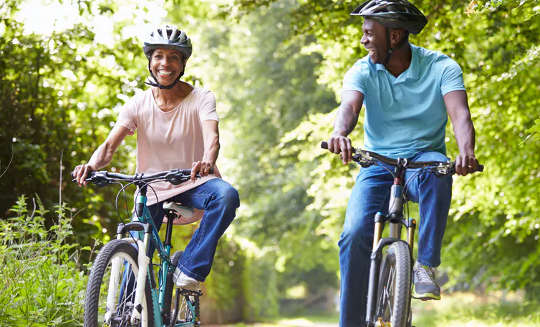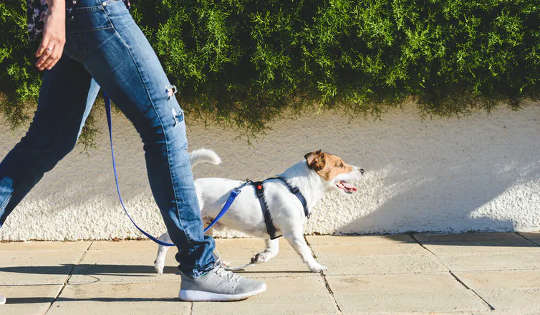
Monkey Business Images/Shutterstock
A new US study shows that people who are less physically active are more likely to be hospitalised and die with COVID-19. According to these new calculations, being inactive puts you at a greater risk from COVID-19 than any other risk factor except age and having had an organ transplant. If this is right, it’s a big deal.
In the study, healthcare providers asked people about how much they exercised over a two-year period prior to the pandemic. Using this information, people were categorised into three groups. The first group – described as “consistently inactive” – exercised for no more than 10 minutes per week. The second group engaged in “some activity” – exercising for between 11 minutes and 149 minutes a week. The third group consistently met physical activity guidelines, exercising for 150 minutes a week or more. Exercise was defined as moderate to strenuous activity, an example being a “brisk walk”.
Compared to people who were exercising for at least 150 minutes a week, people who were consistently inactive were over twice as likely to be hospitalised and to die due to COVID-19. They also had a greater risk of hospitalisation and death than people doing some physical activity.
There are a lot of reasons to trust this study. It uses data from almost 50,000 people who had COVID-19 between January and October 2020. The information on how much they exercised was collected before COVID-19 came on the scene – which means answers it wasn’t affected by people’s COVID-19 outcomes. The researchers also tried to take into account things that might skew the picture – for example, how old someone was and what other health conditions they had.
Get The Latest By Email
However, there are also plenty of reasons to be wary. For a start, people themselves reported how much they exercised, rather than exercise being assessed in some objective way.
The biggest issue, though, is the risk of confounding – that is, of some unmeasured element skewing the picture. This happens when the exposure (in this case exercise) and the outcome (in this case COVID-19 hospitalisation and death) are also influenced by another, unmeasured, variable – the “confounder”.
Take a classic example: murder and ice cream. If you look over the course of a few years, you’ll find that murders rise and fall in line with ice cream sales. No one, however, thinks that ice cream causes murder, or that, having committed murder, one is more likely to eat ice cream.
The issue here is confounding, and the weather is the confounder. Unsurprisingly, ice cream sales are higher when it’s hot out. Interestingly, murders also rise in higher temperatures.
When we think about the relationship between COVID-19 outcomes and physical activity, the possible confounders are almost endless. Long-term health conditions such as diabetes increase COVID-19 risk and can make it more difficult to exercise. Lack of exercise can also cause or worsen some long-term conditions. Though the authors tried to consider this, it will have been difficult to control for it completely.
In addition, independent of age, frailty is a risk factor for worse outcomes from COVID-19, and frailty of course also impacts physical activity. Socioeconomic factors also have a role to play. It is now well known that people from less advantaged groups are at greater risk from COVID-19. Disadvantage is also linked to fewer opportunities to engage in leisure-time physical activities – for the most part the type of exercise this study was measuring.
In short, many behavioural and environmental factors are interlinked, including diet, weight, alcohol and drug use and physical activity. Disentangling the impact of one from another can be extremely difficult.
Despite these limitations, the good news is that it is just generally a good idea to exercise more, whether or not inactivity is a major risk factor for COVID-19. Being more active improves health and wellbeing and reduces the risk of developing diseases. In people already living with long-term health conditions, it can also improve disease management and outcomes.
 Exercise doesn’t have to mean playing sport or going to the gym – dancing, brisk walking or mowing the lawn all count. alexei_tm/Shutterstock
Exercise doesn’t have to mean playing sport or going to the gym – dancing, brisk walking or mowing the lawn all count. alexei_tm/Shutterstock
The World Health Organization tells us that some physical activity is better than none and that more physical activity is even better. It also highlights the need to reduce sedentary time – namely time spent sitting or lying down.
So whether or not inactivity doubles the risk of dying from COVID-19, meeting physical activity guidelines is a sensible suggestion. And perhaps the thing to like most about this study is that unlike some of the other risk factors for COVID-19, physical activity is modifiable. We can’t change our age. For the most part, our long-term health conditions are with us to stay. But with the right supports in place, most of us can be more active.
About the Author
Jamie Hartmann-Boyce, Senior Research Fellow, Departmental Lecturer and Co-Director of Evidence-Based Healthcare DPhil Programme, Centre for Evidence-Based Medicine, University of Oxford
books_exercise
This article is republished from The Conversation under a Creative Commons license. Read the original article.







